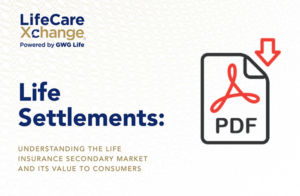The U.S. life settlement industry appears to be well positioned for sustained long-term growth, based on sales trends, consumer demographics and awareness, the regulatory environment, improved industry infrastructure and an influx of capital from institutional investors.
The optimism was evident recently at the Life Insurance Settlement Association’s (LISA) 22nd Annual Spring Life Settlement Conference, held in May in Chicago.
“The future of the U.S. life settlement market has never looked brighter, fueled by demographics trends that offer enormous potential to drive growth,” said Colin Devine, Principal of C. Devine & Associates and a veteran life insurance industry analyst. “With 75 million Baby Boomers retiring, there is no single solution that will address all of their financial challenges. Life insurance settlements may increasingly become a core financial planning tool for these seniors as they look at all available assets to produce retirement income and address long-term care needs.
The Deal, a business unit of TheStreet Inc., issued results from its annual survey of the life settlement market in early June, showing that transactions increased 32.6% last year. The report showed the total face value of life insurance policies sold hovered around $1.65 billion in 2015, the same as the prior year – but there was a big increase in the number of transactions (1,123 policies sold) that expressed the market’s growing interest for smaller-face policies.
“The life settlement market seemed to be making a comeback with a renewed focus on purchase of smaller policies,” said Donna Horowitz, senior editor of The Life Settlements Report, a service of The Deal. “The market is poised for further growth, as the trend appears to be continuing. In recent years, the secondary market took a back seat to the tertiary market in which portfolios of previously purchased policies are traded. That may no longer be true.”
In all, $325.12 million was paid to purchase policies last year compared to $314.28 million paid the year before by the Top 15 providers.
Top 5 settlement buyers:
- Life Equity LLC led the market in the total number of transactions, buying 181 policies in 2015 compared to 112 policies the year before. Life Equity paid $31.42 million and purchased $332.78 million in policies.
- Coventry First LLC paid $22.91 million last year. Policies purchased by Coventry totaled 168 transactions with $108.78 million in face value.
- Abacus Settlements LLC had 106 transactions last year, compared to 53 in 2014. Abacus Settlements paid $53.81 million for $184.53 million in face value last year.
- GWG Life LLC paid $38.04 million for 105 transactions with a face value of $180.37 million. In 2014, GWG Life did 36 transactions with a face value of $55.5 million.
- Settlement Group Inc. ranked fifth with 93 settlements, $7.6 million paid and a face value of $87.43 million.
“There are encouraging signs that we have transitioned to growth from all corners of the life settlement industry,” said Cyndi Poveda, CEO of Life Equity LLC and chair of LISA, at the May gathering of industry leaders. “Consumer awareness of the life settlement option is growing, the infrastructure of our industry is stronger and capital continues to enter the market from institutional investors. This is a healthy industry that is well positioned for sustained long-term growth.”
For those unfamiliar with the market, a life settlement is the sale of a person’s life insurance policy to a third-party investor. In a life settlement, the policy’s owner transfers the ownership of that policy in exchange for an immediate cash payment from the buyer. Candidates for life settlements are typically 65 or older, with a life insurance policy that has a face value of more than $100,000.
“As consumer awareness of life settlements increases, and seniors begin to strike out on their own to explore the possibility of selling a life insurance policy, the next frontier for our industry may be connecting consumers directly with a broker or a provider to purchase that policy,” said Darwin M. Bayston, CFA, President and CEO of LISA.
Minneapolis-based GWG Life LLC, a specialty finance company that ranked fourth among the top buyers listed above, announced in May that its portfolio of life insurance policies now exceeds $1 billion in face value of benefits.
To Bayston’s point about connecting consumers directly with a broker being the next frontier, GWG is experiencing success with its Appointed Agent program, a proprietary policy origination initiative that enables insurance and financial professionals to easily help their clients access the value of their policies through the life insurance secondary market by working with GWG.
“The diversification of our policy origination platform has resulted in a significant increase in the number of policies received and purchased directly through our Appointed Agents,” said Michael Freedman, GWG President.
As of March 31, 2016, the Appointed Agent program accounted for 23% of the total pipeline of life insurance policies under review by GWG, and 13% of all policies purchased in the first quarter. GWG purchased 75 new life insurance policies in the first quarter of 2016 with an aggregate of $102 million in face value of benefits.
“GWG is realizing its goal of being a new leader for a new era in the life insurance secondary market,” Freedman said. “GWG is operating an industry-leading system for underwriting and purchasing policies that is well-suited for the life insurance secondary market.”
GWG also just won a Marketing Communications “Best of Show” award from the Insurance Marketing & Communications Association (IMCA) in the Broadcast Media Spot or Campaign category. The award-winning entry featured Freedman as a guest on two televised segments: Lifetime’s The Balancing Act and Modern Living with kathy ireland® as sponsored programming.
One of GWG’s main objectives for the broadcast campaign was to build awareness for the life insurance secondary market. IMCA judges commended GWG for taking a lead in educating the public about a little-known financial resource, and conveying a targeted and compelling message to a specific audience segment.
The broadcast programs provided targeted media support for GWG member agents and financial professionals whose clients and prospects are seniors and retirees. Freedman’s appearances generated sharp increases in GWG website traffic and its YouTube channel hits.
“We’re pleased to have been recognized by IMCA for this campaign and what it represents in our efforts to expand awareness among seniors and their families about the value of the life insurance secondary market,” said Freedman. “Most Americans don’t know their life insurance policy is an asset that can be sold, making it a valuable source of income for seniors when they need it most.”
• Comments about the article, or care to share your experience with the life settlements market? Please visit this thread: Stars aligning for Life settlements market?
When a life settlement fits
LISA estimates Americans aged 65 or older leave more than $100 billion in benefits on the table each year by lapsing or surrendering their life insurance policies.
As Leo LaGrotte of Indianapolis-based Life Settlement Advisors pointed out in a recent blog, life settlements still aren’t a mainstream opportunity most advisors think of as they work with older clients – even though the life settlements market has existed for more than 20 years.
Most advisors, LaGrotte says, may only run across an opportunity for a life settlement every two or three years at the absolute most—it may be 10 or more years between these chances. He says many advisors are not talking to their elderly clients about life settlements as they do not have a comfort level or general understanding of the process and/or the possible benefits to the seller.
“Life settlements are not great options for everyone, but when they are, they open up a world of possibilities for both alternative investment opportunities, as well as discretionary income for the insured to spend how they see fit, whether it’s a down payment on a vacation home or simply putting it away for the future,” LaGrotte says. “After all, over 80% of all life policies will lapse or are surrendered. That means a lot of investment dollars go to waste.”
But how can an advisor know if a client is a good fit for a life settlement? There are a few best practices recommended in the industry.
LaGrotte says most of the seniors who utilize life settlements have policies that are either underperforming, or simply have a policy they don’t want or need anymore.
The candidates for life settlements all share a few common traits. Specifically, the insured needs to be 65 years or older with a life expectancy of 3-12 years. Any policy worth $100,000 or more is a great start, and it’s best if the insured has experienced a change in insurability since they got the policy. The policy should also be beyond the 2-year contestability period.
Some life insurance policies work better for life settlements than others do. The three most common types of policies that are purchased are Universal, Whole Life, and convertible Term Life. However, LaGrotte says the following also qualify:
• Adjustable Life
• Survivorship or Joint Life
• Portable Group Life (as long as it’s convertible)
• Key Man or Corporate Owned Life Insurance (COLI)
It’s understandable that most financial advisors aren’t familiar with the life settlement market or the process for selling a life insurance policy. Because of that, of course, it’s best practice to get in touch with a professional who works heavily, if not exclusively, in the life settlement market.
Most states regulate life settlements
Today’s life settlement marketplace is heavily regulated. As the LISA website points out, 42 states and the territory of Puerto Rico regulate life settlements, affording approximately 90% of the U.S. population protection under comprehensive life settlement laws.
Of this group, 31 states have a statutorily mandated two-year waiting period before one can sell their life insurance policy from the time of issue, while 10 states have five-year waiting periods and one state (Minnesota) has a four-year waiting period.
Most states have provisions within their life settlement acts where one can sell their policy before the waiting period if they meet certain criteria (i.e. owner/insured is terminally or chronically ill, divorce, retirement, physical or mental disability, etc.).
• Comments about the article, or care to share your experience with the life settlements market? Please visit this thread: Stars aligning for Life settlements market?













